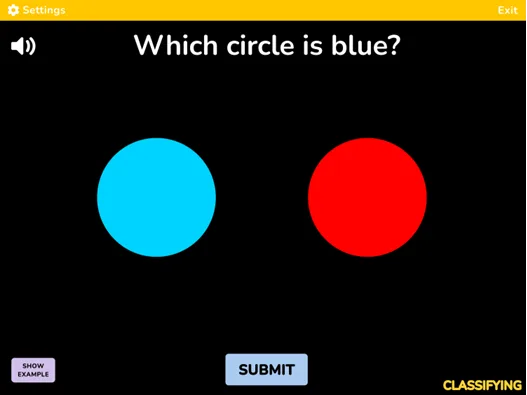
Guest blogger Adele Smolansky is the founder and CEO of AI-Learners, an educational website for students with CVI and other complex needs. Adele is a recent graduate from Cornell University (Computer Science) and is pursuing a PhD at Stanford University in AI for special education. Adele has previously worked at Google Inc. as a software engineer.
Founding Story
My younger sister, Lara, has a rare neurological disability called Rett Syndrome. Lara uses an eye gaze Tobii Dynavox to communicate and access a computer. Growing up, I watched Lara struggle to learn math. Lara’s challenges increased as she greatly struggled to engage in online learning.
Most online learning platforms are incompatible with her assistive technology, so Lara cannot be independent. Next, engagement features on these platforms are too simple or overwhelming for Lara. Her teachers also want to customize the colors, size, and spacing of visuals and adjust the math difficulty, and our parents want analytics to understand Lara’s academic abilities better.
Inspired to help my sister learn math, I created a few online math games accessible to her eye gaze device. Within a few weeks, her teachers and therapists felt the games could help many other students with disabilities.
AI-Learners Overview
To help millions of students with disabilities, I created AI-Learners, an educational technology platform to help students with all abilities learn foundational math, literacy, and daily life skills. The platform offers 100+ games to help students practice counting, addition and subtraction, geometry, logical reasoning, color and object recognition, time and money, letters, sight words, and more. The games align with common core standards preK-2nd grade, but students of all ages and grades can benefit from the platform.
You can watch a 3-minute video demonstrating the website and keep reading for more information!


AI-Learners also provides robust analytics to help parents and educators better understand their math progress, strengths, and weaknesses. You can use these analytics for IEP meetings to demonstrate your students’ progress toward their educational goals.

AI-Learners Accessibility
I created AI-Learners to support students with CVI and other vision impairments, learning challenges, behavioral complexities, and varying physical needs. The platform is compatible with assistive technology such as eye gaze, magnifiers, screen readers, and switch devices.
To support each student, AI-Learners offers an expansive suite of customization options. For instance, adjust the instructions’ color, key terms, and main visuals. Change answer choices’ color too. Modify visual arrays and answer choice spacing. Alter font size and style, and object sizes. You can also tailor game length, answer options, reinforcement type, and the amount of breaks.
Research and Advisors
To develop AI-Learners, I’ve collaborated with Cornell University researchers and with hundreds of education and accessibility professionals. I interviewed special education teachers, parents, teachers of the visually impaired (TVIs), speech and language pathologists (SLPs), ABA specialists, occupational therapists, AT specialists, and other professionals.
Most recently, I conducted a research study with the Cornell Enhancing Ability Lab, led by Professor Shiri Azenkot, investigating how educational technology can better support students with CVIs. I interviewed 20 TVIs and 25 other school supporters and homeschool parents. I used the research findings to improve AI-Learners and the website’s effectiveness.
I’m now advised by incredible researchers and educational leaders in the CVI field. Matt Tietjen has been meeting with me weekly to help me further improve the accessibility of AI-Learners, develop new game designs, and provide better customization support for teachers. I’ve also been fortunate to receive help from Dr. Christine Roman, Sue Sullivan, Chris Russell, and Lisa Miller.
Current Impact
Hundreds of students are using AI-Learners all across the country! Parents have created individual accounts for their children to use AI-Learners, and teachers use AI-Learners with their kids at school.
Over 25 schools are starting free 3-month trials in September. We are working with schools for students who are blind or low vision, such as Perkins School for the Blind, Utah Schools for the Deaf and Blind, and Lighthouse Miami; schools for students with autism, such as Brooklyn Autism Center; and other private or public schools that serve students with a range of abilities.
Next Steps
As a parent, you can create an individual AI-Learners account for your child to use at home. Signing up is free! You can create an account in just a few minutes at www.ai-learners.com/signup.
If you want your child to use AI-Learners at school, you can suggest that the school sign up to use the platform. All schools receive a free 3-month trial to start!
I am extremely passionate about improving opportunities for special education students. I would love to chat with you to see how I can better support your child! You can reach me at [email protected].